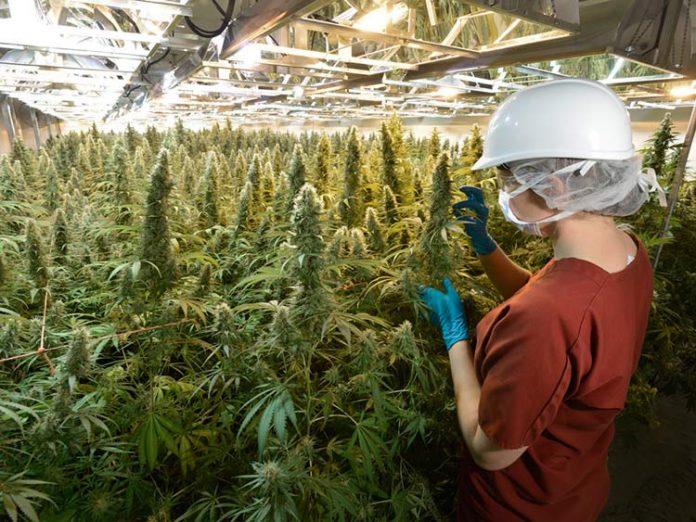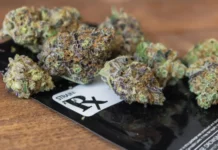Rhode Island’s expanding number of newly licensed medical marijuana cultivators are growing their products in about a half dozen communities, but you might not know it from the outside of the operations.
There are no bright signs you see on pharmaceutical plants but medical marijuana growers acknowledge they are working on their respective brands that are part of an industry that sold about $27 million worth of pot last year.
“We want to definitely develop a certain brand of high quality, efficient clean medicine,” said Ted Grillo, who co-manages a marijuana grow in a nondescript, industrial building in Warwick.
Providence, Cranston, North Kingstown, Central Falls, Exeter and West Warwick are all home to licensed growers.
Warwick has 14, more than half of the 24 medical marijuana cultivator licenses issued by the Department of Business Regulation (DBR) since Dec. 2016.
The large grows are expected to help supply more than 19,000 medical marijuana patients, but most of them are currently getting the drug from more than 2,000 caregivers who are licensed with the Department of Health.
Forty-two other applications have been approved in a number of other communities that would stretch the state’s marijuana belt from Richmond to Cumberland and across Portsmouth and Exeter.
The law does not put a cap on the number of growers the state can license.
Norman Birenbaum is the DBR’s Principal Policy & Economic Analyst who developed the new licensing procedures, but his title has sometimes been shortened to “The Pot Czar.” He said one goal of the new process is to eliminate issues caused by widely scattered growers who planted their crops in attics, garages and basements.
“We didn’t know who was growing, where they were growing, under the conditions they were growing,” Birenbaum said. “And it was widely known some were supplying the illegal market.”
The newly licensed operations supplied about 25 percent of the medical marijuana consumed last year.
Watching Every Leaf
The first thing you notice when you walk into the Warwick operation is the security cameras, connected to the DBR via remote log-in.
“How many fingers Pete?” Birenbaum asked, holding up his hand for the lens.
“I see four fingers,” Pete answered.
Several other cameras focus on the parking lot and loading docks and peer into the grow rooms, seemingly watching every leaf. (We were cautioned not to touch the plants.)
The rooms support different climates, including high enough humidity to fog up our lens in one area.
Other rooms were drier and hotter, as the facility tries to give its crop the optimal opportunity to flourish.
Looped around the stalks of the plants are bar codes with information that is recorded into the state’s data base of about 60,000 legal plants.
Zach Allen, co-manager of the Warwick grow we toured, was checking in the plants that are closest to harvesting.
“We’re able to grow a more consistent plant,” Allen said. “And more securely.”
Chemistry of Cannabis
A key component of what is being grown is the chemistry of cannabis, which is depicted in molecular formulas sketched on white boards and windows.
Cultivators are trying to unlock ways to grow plants with stout levels of tetrahydrocannabinol, or THC. THC is the main, mind-altering ingredient found in cannabis, and is also credited with relieving pain and nausea.
Other plants are said to be important for their levels of cannabidiol (CBD). CBD does not get the consumer high but it has more medicinal uses, recommended for seizures, anxiety and other applications.
“We can extract them, and produce tons of other products to really hone in those numbers and apply a product that has a specific percentage of THC and CBD,” Grillo said.
While you can smell the cannibis in the individual rooms, large carbon filters clean the air before it escapes into the neighborhood.
The Incredible Edible
“So no one is going to smell it outside,” Grillo explained.
As we toured the Warwick facility, the wraps had just come off a new extraction lab.
It uses non-flammable carbon dioxide to pull compounds out of the plant.
The illegal market version of the process that produces butane hash oil is blamed for fires across the state and nation.
The 2015 Kinsley Avenue mill fire was started by a hidden BHO lab, and a deadly fire in July of that year in South Kingstown was blamed on the same type of explosion.
Allen and Grillo agree the demand for extracts is growing especially fast.
“Medicinally speaking, vaporizing is always going to be healthier,” Allen said. “As well as ingesting it orally whether through a syringe in its raw form or through other various edibles”.
THE FUTURE
Whether smoked, vaped or eaten, marijuana production is expected to expand quickly in a state where the number of medical marijuana users is inching toward 20,000.
Add to that formula, a list of proposals from Governor Gina Raimondo, including expanding the number of compassion centers from 3 to 15 and widening what the drug can be used for by patients.
And the big one — legalizing recreational use, currently being studied by a commission that’s expected to provide a report on the issue in the spring.
Allen and Grillo say the focus of the grow they run is “medicine.”
Birenbaum offered a similar answer about the impact of recreational use.
“Right now, we’re just trying to make sure that regulated medicine is as accessible as possible,” Birenbaum said. “So, that people don’t think they need to grow in their homes in potentially dangerous conditions.”
But he acknowledged some medical marijuana license applicants were looking ahead.
“Some people put [recreational marijuana references] in applications because they’re trying to get ahead of where the state is,” Birenbaum said. “Nothing that we’ve done right now is looking toward recreational marijuana.”














